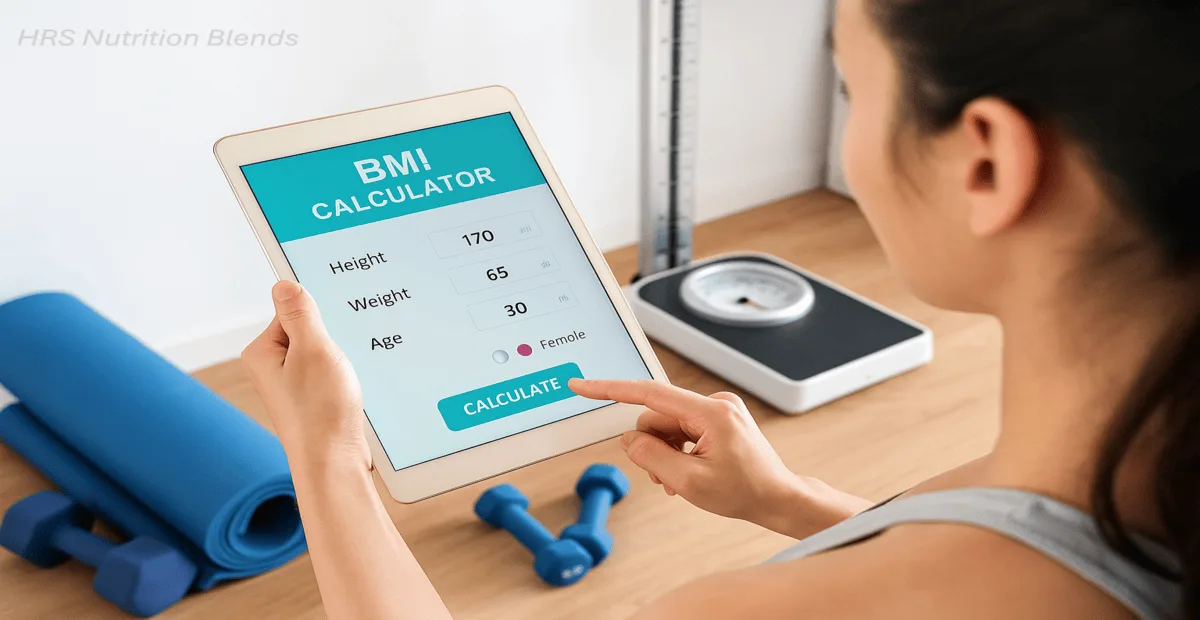If you want to improve your health, one of the simplest and most effective tools you can start with is a BMI calculator. Body Mass Index (BMI) offers a quick way to assess whether your weight is in a healthy range for your height. While BMI has some limitations, it is widely recommended by trusted organizations including the World Health Organization and the National Institutes of Health. You only need your height and weight to get started. Using our BMI calculator, you can obtain accurate results immediately.
Regularly using a BMI calculator helps you track your weight status over time, uncover important trends, and make informed lifestyle choices that enhance your long-term health. Whether you are monitoring your own wellness, supporting a family member, or simply curious, this guide will equip you with useful knowledge and practical tools to begin your health journey confidently.
As a wellness coach with over five years of experience, I emphasize balanced nutrition, mindful eating, and sustainable daily habits. This article integrates those evidence-based principles with practical BMI insights to empower your path toward lasting wellness. Small, consistent changes, informed by tools like a BMI calculator, create powerful health results.
How to Calculate Body Mass Index Accurately
The calculation of BMI is simple but requires accurate measurements. The formula works in both metric and imperial systems:
- Metric Units: BMI = weight in kilograms divided by height in meters squared (kg/m²).
- Imperial Units: BMI = [weight in pounds divided by height in inches squared] multiplied by 703.
For example, a person who weighs 70 kilograms and is 1.65 meters tall would calculate BMI as 70 ÷ (1.65 × 1.65) = 25.7. Precision matters: minor errors in measuring your height or weight can affect the accuracy of your BMI.
To avoid manual calculations and increase accuracy, use our BMI calculator. It provides instant, reliable results along with WHO category classifications for easy interpretation.
Understanding the Different BMI Categories
The World Health Organization categorizes BMI into ranges linked with specific health risks. Understanding these helps contextualize your results from a BMI calculator:
| BMI Range | Category | Possible Health Implications |
|---|---|---|
| Below 18.5 | Underweight | Potential nutrient deficiencies, weakened immunity, fatigue |
| 18.5 – 24.9 | Healthy weight | Lower chronic disease risk, balanced energy |
| 25 – 29.9 | Overweight | Elevated risk of heart disease, diabetes, metabolic syndrome |
| 30 and above | Obese | Significantly increased risks for cardiovascular disease, diabetes, certain cancers |
A client I worked with found that after several months of working remotely, her BMI calculator readings showed a gradual increase into the overweight category. With this early insight, she introduced daily walks and mindful meal planning, successfully stepping back into the healthy range over six months through sustainable changes instead of restrictive dieting.
Why Monitoring BMI Regularly is Important
A single BMI measurement gives you a snapshot, but regular checks reveal trends that inform better decisions. Monthly BMI calculator use enables you to catch small changes early before they become significant health issues.
For example, a remote worker incorporated monthly BMI tracking into her routine. She noticed a slow upward trend, which motivated her to add simple weekly workouts and improve her snack options. This resulted in her regaining a healthier BMI and improving her overall energy.
Monitoring consistently also helps you understand how life events, hormonal shifts, or lifestyle changes like travel and stress affect your weight and metabolism.
How BMI Differs for Women, Men, Kids, and Seniors
BMI interpretation varies by demographics, so use your BMI calculator results with context:
- Women: Hormonal fluctuations, pregnancy, and menopause influence body fat and BMI. Combining BMI with waist circumference measurements offers better insight.
- Men: Higher muscle mass may inflate BMI scores without indicating excess fat.
- Children and Adolescents: Use age- and sex-specific percentile charts rather than adult cut-offs. A BMI calculator for kids combined with growth charts helps parents track healthy development.
- Athletes: Increased muscle mass can result in high BMI despite low fat content. Body fat tests can complement BMI calculator data.
- Seniors: Muscle loss with age (sarcopenia) may lead to underestimated fat levels; additional assessments are important.
For instance, a competitive cyclist with a higher BMI used body fat percentage measurements alongside the BMI calculator to confirm athletic muscle mass was driving his reading, not unhealthy fat accumulation.
Simple Steps to Get the Most Out of BMI Tracking
- Consistently measure: Weigh yourself with consistent timing and conditions (e.g., mornings, light clothes).
- Measure height accurately: Stand upright without shoes, heels against a wall.
- Use an accurate BMI calculator: Enter measurements into our BMI calculator for precise results and categorization.
- Track month-to-month: Log results to spot trends rather than fixate on daily variability.
- Use insights to act: Adjust diet, activity, hydration, and rest to maintain or improve healthy BMI.
One client made BMI tracking a monthly habit. When she noticed a creeping rise, the data became motivation to prioritize weekend hikes and healthier snacks, resulting in sustained improvements.
Using BMI with Other Health Check Tools
BMI alone cannot tell the full health story. Pair it with these metrics for a thorough assessment:
- Waist circumference to evaluate abdominal fat risk.
- Body fat percentage for accurate body composition.
- Basal Metabolic Rate (BMR) via our BMR calculator to tailor calorie intake.
- Physical fitness assessments for cardiovascular health, strength, and flexibility.
A client with an overweight BMI was reassured by normal waist circumference and low body fat, guiding focus to maintaining fitness and not unnecessary weight loss.
Practical Lifestyle Tips to Improve Your BMI
- Balanced nutrition: Follow the Best Effortless Indian Diet Plan, emphasizing whole foods such as vegetables, nuts, legumes, lean proteins, and complex carbs.
- Regular physical activity: Aim for 150 minutes of moderate exercise weekly plus strength training. Find enjoyable activities like walking, dancing, swimming, or yoga to sustain practice.
- Hydration: Use the Water Intake Calculator to ensure adequate fluid intake supporting metabolism and wellbeing.
- Meal planning: Use our Meal Planning Templates and Balanced Plate Visual Guide to structure meals balanced in nutrients and appropriate portions.
- Sleep and stress management: Prioritize 7–9 hours of quality sleep and practice mindfulness or relaxation techniques to mitigate stress-related impacts on weight.
Clients who align BMI tracking with these lifestyle improvements report steady energy gains, improved mood, and gradual, sustainable changes in weight and health.
Common Myths and Misunderstandings About BMI
- Myth: A normal BMI means perfect health.
Reality: Health is multifaceted and depends on fitness, diet, and genetics alongside BMI. - Myth: High BMI always means excess fat.
Reality: Muscle mass and bone density can raise BMI without increasing fat. - Myth: BMI applies identically to all ethnicities.
Reality: Health risk thresholds in BMI may differ between populations. - Myth: Minor BMI fluctuations require major action.
Reality: Normal daily weight changes occur; focus on long-term trends.
Your Next Steps Toward a Healthier You
Start today by calculating your BMI with our BMI calculator to establish your baseline. This simple step sets the foundation for tracking progress and celebrating wins over time.
Next, determine your daily calorie needs using our BMR calculator, enabling you to optimize nutrition according to your goals.
Embrace balanced eating with the Best Effortless Indian Diet Plan and organize your meals using meal planning templates for success.
Finally, utilize the Wellness Starter Guide for holistic lifestyle enhancement. Remember, small, consistent actions lead to lasting well-being, and a BMI calculator is a powerful tool to keep you informed and motivated on your journey.
Conclusion: Turning Knowledge into Action
Understanding and tracking your BMI with a reliable BMI calculator is just the beginning of your wellness journey. Throughout this guide, we’ve explored how to calculate BMI accurately, interpret what it means for different groups, combine it with other health metrics, and apply it to everyday lifestyle choices. This knowledge becomes truly powerful when you use it consistently over time.
Remember — your BMI is not a judgment; it’s a useful indicator to help you make informed decisions. By pairing regular BMI checks with balanced nutrition, enjoyable movement, proper hydration, and adequate rest, you give yourself the best chance to maintain or achieve a healthy weight range that supports your energy, confidence, and long-term health.
Start today by taking that first measurement. Track it, learn from it, and let it motivate you to keep making choices that serve your body and mind. Over time, these small, steady actions lead to lasting results and you’ll have tangible progress to show for your efforts.
Frequently Asked Questions About BMI Calculators
Q1. How often should I use a BMI calculator?
Monthly checks are optimal to track meaningful trends without anxiety over daily fluctuations.
Q2: Can athletes trust BMI results?
BMI can be misleading for athletes due to muscle mass; pair it with body fat and fitness assessments for accuracy.
Q3: Is BMI relevant for children?
Yes, but use age- and sex-specific percentile charts alongside a BMI calculator designed for kids.
Q4: What is a healthy BMI range?
Generally, 18.5 to 24.9 is ideal for most adults, but individual factors matter.
Q5: What should I do if my BMI is outside the normal range?
View your BMI as guidance to evaluate habits. Consult a healthcare provider for personalized advice and consider gradual lifestyle adjustments.
Q6: Can weight loss alone improve BMI?
Weight loss can reduce BMI, but combining it with strength training and balanced nutrition ensures healthier, sustainable changes.
Q7: Is BMI the best measure of health?
BMI is a useful starting point but should be combined with other health indicators to get a comprehensive understanding of wellness.
Disclaimer: This article is for educational purposes only and does not replace personalized medical advice. Always consult your healthcare provider before making significant lifestyle changes.

I’m a passionate wellness coach with over 5 years of experience helping people build healthier lives through balanced nutrition and practical lifestyle habits. I focus on science-backed guidance, including whole foods, mindful eating, and smart protein choices, to support energy, digestion, and long-term well-being. My approach is flexible, realistic, and built on the belief that prevention is better than cure because lasting health starts with daily choices.

